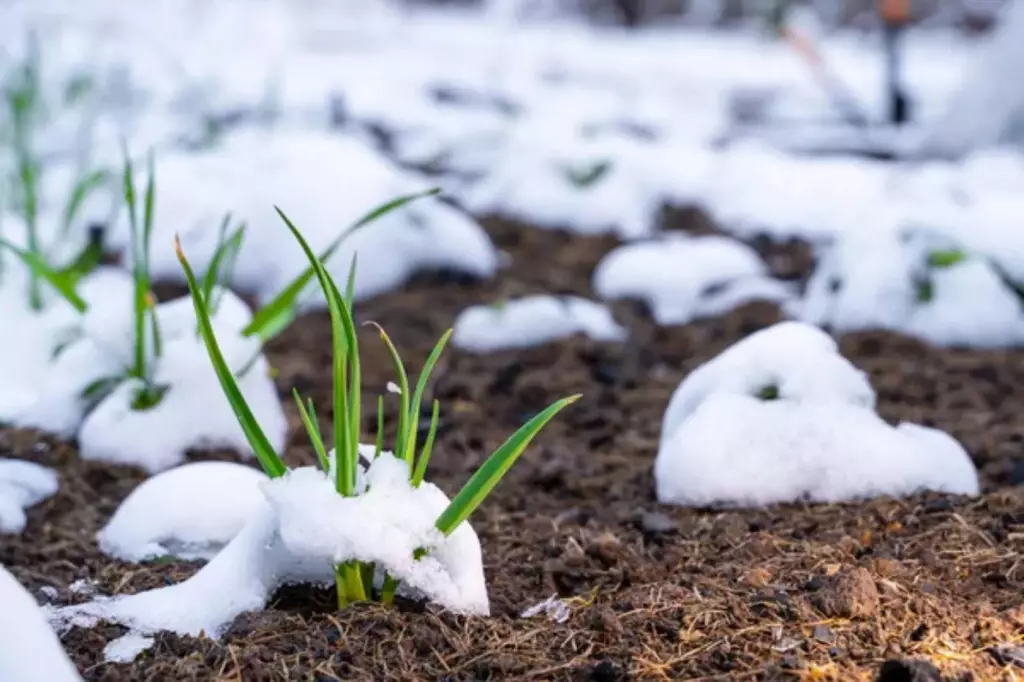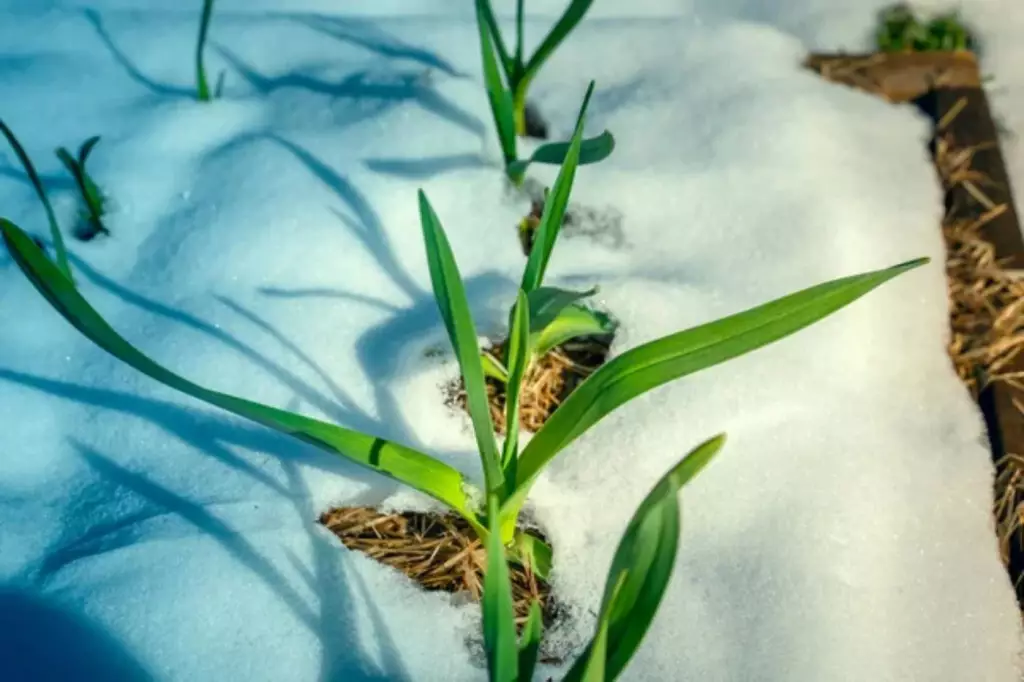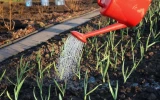Can Garlic Plants Survive Frost? (How and for How Long)
Garlic plants are a staple in many gardens, often sparking curiosity about their cold-weather resilience. These hardy plants have a surprising ability to withstand frost, equipped with natural mechanisms that protect them during chilly seasons. In this article, we will delve into the fascinating world of garlic cultivation, specifically focusing on the plant's ability to withstand frost.
Garlic plants can survive frost and cold temperatures. They are hardy to USDA zone 3 and can tolerate temperatures down to -30°F (-34°C) once established. Garlic is planted in the fall, grows roots before the ground freezes, and resumes growth in early spring, making it resilient to frost.
However, too much of a good thing can turn bad. If the frost turns into a prolonged deep freeze without proper protection, even these resilient plants may struggle. Let's find out how you can protect your garlic during these tough conditions.
Summary
- Garlic plants exhibit a range of physiological and genetic adaptations, such as dormancy, vernalization, production of antifreeze proteins, and cellular adjustments, alongside utilizing snow as insulation and undergoing hardening, which collectively enable them to effectively withstand frost and cold temperatures.
- While garlic is inherently frost-tolerant, taking steps to protect it from extremely cold temperatures such as applying a thick layer of mulch and considering cloche protection for unexpected late frosts are effective strategies to reduce the risk of damage.
- Frost impacts on garlic include potential temporary stunting of early growth, but with adequate protection, garlic can maintain a robust flavor profile and yield despite cold conditions.

On this page:
Can Garlic Survive Frost?
Garlic is robust enough to withstand frost due to its cold-hardy nature, making it suitable for planting in a variety of climates. Its ability to survive frost is crucial for its growth cycle.
How do garlic plants survive frost?
Garlic plants possess several adaptations that enable them to survive and even thrive despite exposure to frost, such as the following:
Undergoing dormancy and vernalization

Garlic plants enter a state of dormancy during the colder months. This physiological process slows down their metabolic activities, reducing their growth and energy consumption. This dormancy allows them to withstand colder temperatures without sustaining damage.
Garlic also requires a period of cold weather to initiate or speed up the flowering process, known as vernalization. The cold period essentially 'tells' the garlic plant that winter has come and gone, making it safe to grow, flower, and reproduce.
This process ensures that the plant only begins its active growth phase once the threat of severe frost has passed, thus protecting it from unexpected cold spells.
Some garlic varieties have antifreeze proteins
Some plants, including certain varieties of garlic, can produce antifreeze proteins (AFPs). These proteins bind to ice crystals within the plant, preventing them from growing larger and causing cellular damage.
This mechanism allows the plant cells to avoid rupture that would occur from ice expansion inside the tissues.
Making adjustments in their cell structure and osmotic properties
Plant cells can alter their structure in response to cold, making them more flexible and less prone to damage as temperatures drop.
For garlic, this might involve changes in the composition of cell wall materials or adjustments in cell membrane fluidity, which help maintain cell integrity during frost.
Garlic and other cold-tolerant plants can also accumulate solutes such as sugars, amino acids, and certain ions inside their cells.
This lowers the freezing point of the cell sap, effectively acting as an antifreeze. These solutes can also help stabilize cell structures and maintain cellular functions during cold stress.
Using snow as a winter cover
A natural insulator, snow can protect garlic plants from the harsher aspects of winter. A blanket of snow keeps the soil underneath it relatively warm, preventing the garlic bulbs from freezing.

This insulation effect helps maintain a stable environment for the dormant garlic, safeguarding it against temperature fluctuations that might otherwise harm the plant.
Going through hardening or cold acclimation
Before the arrival of winter, garlic plants undergo a process known as "hardening" or "cold acclimation."
During this period, they gradually expose themselves to decreasing temperatures, which triggers an increase in the concentration of certain solutes in their cells and induces other protective measures against the cold.
This gradual exposure helps the plant to better withstand the cold temperatures of winter.
Some garlic varieties have evolved genetic adaptation to the cold temperature
Over generations, garlic plants have evolved genetic adaptations that enhance their cold tolerance. These adaptations are the result of natural selection in cold climates, where only the plants best equipped to handle low temperatures would survive and reproduce.
Such genetic traits are passed down and can include a variety of physiological and biochemical mechanisms geared toward frost survival.
How long can garlic plants survive frost?
Garlic plants can endure frost for multiple weeks or even months depending on the severity and duration of the cold temperature.

Garlic plants are quite hardy and can tolerate cold weather, including frost, especially when planted in the fall. Garlic is often planted several weeks before the first frost in the fall so that the cloves can establish roots before the ground freezes.
Once established, garlic plants can survive winter frosts and even hard freezes. The cold weather is beneficial for garlic, as it triggers the clove to break dormancy and begin new growth in the spring.
In regions with mild winters, garlic can grow throughout the winter months. In areas with severe winters, the plants will go dormant and then resume growing as the weather warms in the spring.
However, you may need to make sure that garlic is planted at the right depth (usually 2-3 inches or 5-7.5 cm deep) and properly mulched to provide adequate insulation from the cold.
If garlic is exposed to prolonged periods of extreme cold without protection, or if there is significant freeze-thaw activity that leads to heaving out of the soil, the plants may be damaged or killed.
How cold can garlic plants tolerate?
Generally, garlic prefers temperatures between 45°F and 75°F for optimal growth. However, it can survive in much lower temperatures, especially when the ground is not persistently covered by snow.
Garlic can survive and thrive in temperatures as low as 0°F (-18°C) or lower once established, especially if the ground is mulched to provide additional insulation. The mulch helps to moderate soil temperature fluctuations and protects the garlic from extreme cold.
The ideal growing conditions for garlic include a period of cold dormancy, which is why planting is recommended in the fall so the plants can establish roots before the deep winter sets in.
During this time, garlic requires minimal care beyond ensuring the soil is well-drained and not waterlogged. As the weather warms in the spring, garlic resumes active growth, leading to bulb development.
During active growth, sustained freezing temperatures could be detrimental, and thus, maintaining a moderate level of humidity around 50-60% can be beneficial for the plants.
How to Protect Garlic From Frost
Preparing your garlic plants to withstand a sudden drop in temperature is critical for a healthy harvest. Using the right materials and techniques, you can ensure that your garlic thrives even when the mercury dips.
Do I need to cover garlic for frost?
While garlic plants are frost-tolerant, you still need to protect them from extreme cold temperatures. Covering garlic can shield it from harsh conditions, reducing the risk of damage. Here are some specific steps you can take:
Use mulch to cover garlic plants
A thick layer of mulch is one of the best defenses against frost.
- Select mulch material: Choose straw, leaves, or grass clippings for insulation.
- Apply mulch: After planting garlic in the fall, apply 4-6 inches of mulch over the bed.
- Check mulch thickness: Throughout winter, ensure the mulch hasn’t compressed or blown away. Add more if needed.
- Remove mulch in spring: Gently pull back mulch as temperatures rise to allow soil warming and garlic growth.
Use cloche protection
For extra protection during unexpected late spring frosts, cover individual plants or rows with cloches (glass or plastic covers), floating row covers, or even blankets. Remove these covers during the day to prevent overheating.

More tips to protect garlic from frost
-
Choosing the right planting time: Plant garlic cloves in the fall, about 4-6 weeks before the ground freezes. This timing allows the cloves to establish roots without sprouting too much top growth before the deep winter sets in.
-
Select hardy varieties: Choose garlic varieties that are known for their hardiness and suited to your climate zone. Hardneck varieties, for example, are generally more cold-resistant than softneck varieties and are better suited for colder climates.
-
Windbreaks: In areas with harsh winds, use windbreaks such as fences, burlap screens, or plant rows of bushes to reduce wind chill, which can exacerbate frost damage.
-
Raised beds: Planting garlic in raised beds can help improve drainage and slightly elevate the bulbs, reducing the risk of frost heave (where bulbs are pushed out of the ground by the freeze-thaw cycle).
-
Watering: Keep the soil evenly moist, especially in the fall before the ground freezes. Well-hydrated soil can hold more heat than dry soil, providing some temperature moderation during cold nights.
-
Avoid high nitrogen fertilizers in the fall: High nitrogen levels encourage leafy growth, which is more susceptible to frost damage. Fertilize with a balanced or low-nitrogen, high-phosphorus, and potassium fertilizer to encourage strong root development without promoting excessive leaf growth.
Effects of Frost on Garlic Plants
Frost can have a significant impact on your garlic plants, influencing their growth, bulb development, and even the flavor at harvest. Understanding these effects helps you ensure a healthy yield.
Will frost kill garlic plants?
Garlic plants are known for their hardiness, particularly in cold weather conditions. They are often planted in the fall in many climates, allowing their roots to establish before the winter freeze.
When exposed to cold, garlic plants go dormant, but they don't die. The cold actually stimulates the garlic plant to divide into the individual cloves that make up a head of garlic. This process is crucial for the development of the garlic bulb.
However, while garlic plants can withstand frost and even snow, there are limits to their cold tolerance. Extremely low temperatures, especially if prolonged and without an insulating snow cover, can potentially damage or kill garlic plants.
The extent of damage can also depend on the garlic variety, as some are more cold-hardy than others. Proper mulching can help protect the garlic plants against severe cold by insulating the ground and providing a more stable temperature environment.
Will frost hurt garlic plants?
During the early growth stages, garlic shoots can be vulnerable to frost, which may stunt growth temporarily. However, once established, garlic plants can endure frost fairly well, making mature plants less sensitive.
While frost doesn't usually hurt mature plants, it can influence the flavor and yield of the harvested bulbs. Ensuring moderate soil temperature through mulching can protect young shoots and aid in maintaining a robust flavor profile.



